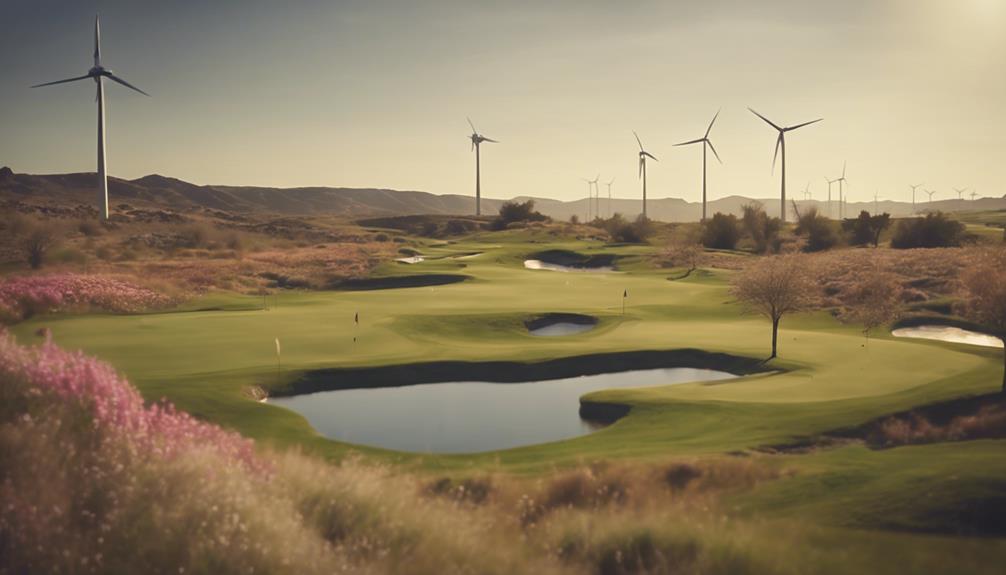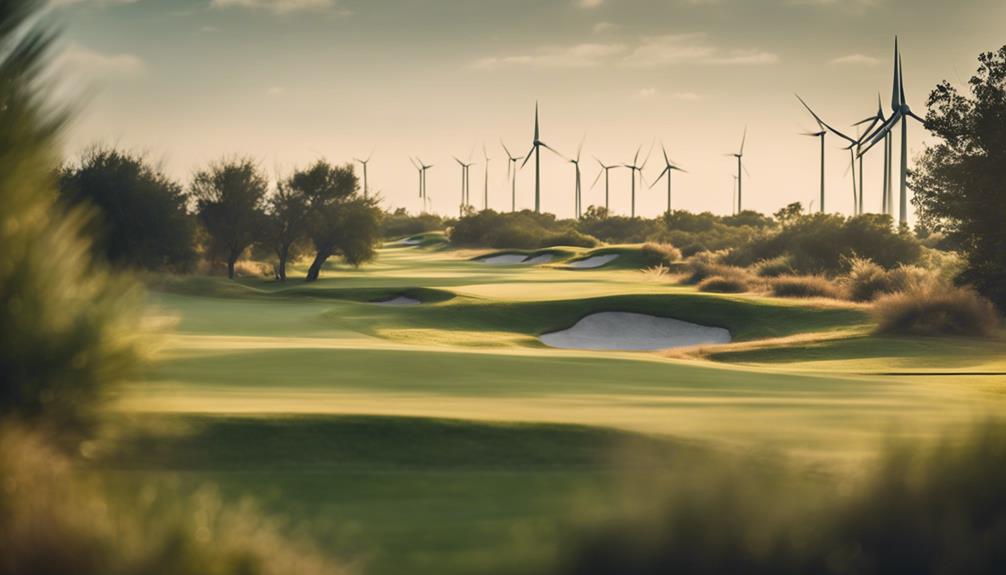- 7 Top Flite Golf Clubs XL for Improved Performance - September 28, 2024
- Top Flite Golf Clubs: Top 5 Reasons to Choose Them - September 28, 2024
- Top 3 Golf Club Fitters for a Perfect Swing - September 28, 2024
You're aware that golf courses occupy a significant amount of land, but did you know they contribute to a carbon footprint ten times that of an individual? Daily water usage averages 93,750 gallons per course, exacerbating water scarcity in drought-prone areas. Furthermore, over 50 pesticides used can contaminate waterways and harm beneficial species. While golf courses pose environmental challenges, they can also enhance local ecosystems and increase biodiversity through sustainable management practices. As you explore the complex relationship between golf and the environment, you'll discover the opportunities for positive change that lie ahead.
Key Takeaways
- Golf courses occupy 2 million acres of land in the US, contributing to habitat loss and a significant carbon footprint.
- Daily water usage averages 93,750 gallons per course, exacerbating water scarcity in drought-prone areas.
- However, sustainable practices like organic fertilizers and integrated pest management can reduce chemical inputs and enhance local ecosystems.
- Approximately 30% of golf courses globally are adopting sustainable practices, such as water conservation and eco-friendly maintenance.
Environmental Impact of Golf
As you step onto a golf course, the serene landscape and lush greenery may belie the significant environmental toll associated with maintaining these spaces, which can have far-reaching consequences for local ecosystems and wildlife habitats.
You mightn't realize that golf courses use over 2 million acres of land in the U.S. alone, resulting in habitat loss and ecosystem disruption.
Additionally, the daily water usage of approximately 93,750 gallons per course contributes to excessive water consumption, particularly in drought-prone areas like Arizona and California.
The pesticides used in the golf industry, with over 50 commonly used, can contaminate nearby waterways and harm non-target species, including beneficial insects and local fauna.
The environmental impact of golf courses is further exacerbated by regular maintenance practices, such as mowing and fertilizing, which result in a carbon footprint ten times that of an individual.
It's essential to acknowledge these environmental consequences and consider adopting sustainable alternatives to mitigate the negative effects of golf courses on the environment.
Golf Course Superintendents' Role
While acknowledging the environmental concerns associated with golf courses, you can play a part in mitigating these issues by recognizing the substantial role golf course superintendents play in implementing sustainable practices that promote ecological balance.
As the primary stewards of the land, superintendents are responsible for managing water quality by utilizing filtration devices to keep irrigation water clean and employing dense turf areas that naturally filter pollutants.
By participating in certification programs like the Audubon Cooperative Sanctuary Program, superintendents can adopt sustainable practices that enhance the ecological impact of their courses.
Additionally, they can reduce pesticide use by understanding local wildlife and implementing integrated pest management strategies, which may involve attracting natural pest control agents like birds and bats.
Water Conservation Strategies

Given the staggering amount of water golf courses consume daily, you can take an essential step towards sustainability by implementing effective water conservation strategies that optimize water usage and minimize waste.
To achieve this, consider the following strategies:
- Optimize irrigation systems: Implement low-pressure irrigation systems and utilize advanced irrigation technology, such as moisture sensors and weather-based controllers, to reduce water waste and improve efficiency.
- Promote drought-tolerant landscaping: Incorporate drought-tolerant plants and native plant usage to minimize water requirements and support local biodiversity on golf courses.
Wildlife and Habitat Management
As you explore the domain of wildlife and habitat management on golf courses, you'll discover the importance of promoting native plants, creating habitats for diverse species, and maintaining ecological balance.
These key strategies can transform golf courses into thriving ecosystems that support local biodiversity.
Native Plant Promotion
By incorporating native plants into their landscaping, golf courses can greatly enhance local biodiversity, providing essential food and habitat for wildlife adapted to the region. As you consider the environmental impact of golf courses, promoting native plants can have a significant positive effect.
Here are three key benefits of native plant promotion on golf courses:
- Reduced chemical use: Native plants require less maintenance and are more resilient to local pests and diseases, reducing the need for chemical fertilizers and pesticides.
- Improved water management: Drought-resistant native species can help decrease water consumption, which is vital in areas facing water scarcity.
Wildlife Habitat Creation
You can take your commitment to environmental stewardship a step further by designing golf courses that double as wildlife habitats, incorporating natural areas and native vegetation to support diverse species and promote biodiversity.
By doing so, you can create wildlife sanctuaries that provide a haven for native plants and animals. For instance, installing birdhouses and bat boxes can attract natural pest control agents, reducing the need for harmful pesticides.
Ponds can be stocked with fish to control algae growth, contributing to a balanced aquatic ecosystem. Furthermore, understanding local climate and site conditions enables golf course superintendents to implement environmentally sound management practices that support the thriving of native plants and wildlife.
Many golf courses have already taken the initiative, participating in programs like 'Monarchs in the Rough' to create habitats for endangered species such as the monarch butterfly.
Ecological Balance Maintenance
Golf course superintendents can maintain ecological balance by implementing effective wildlife and habitat management practices that prioritize native species, reduce pesticide use, and promote biodiversity.
By adopting environmentally friendly approaches, you can create habitats for endangered species and support local ecosystems.
Here are three ways to achieve ecological balance:
- Native species prioritization: Focus on preserving and promoting native plant and animal species, which are better adapted to local conditions and require fewer maintenance resources.
- Integrated pest management: Implement non-chemical methods to control pests, such as introducing natural predators or using physical barriers, to reduce pesticide use and minimize harm to non-target species.
Sustainable Practices in Golf

As the golf industry shifts towards a more environmentally conscious approach, many courses are now embracing sustainable practices that prioritize ecological stewardship and resource efficiency. You'll find that eco-friendly practices, such as using organic fertilizers and integrated pest management, are becoming the norm. The Audubon Cooperative Sanctuary Program (ACSP) is a leader in promoting sustainable practices, focusing on water conservation, wildlife habitat creation, and chemical safety.
Here are some examples of sustainable practices in golf:
| Practice | Benefits | Examples |
|---|---|---|
| Organic fertilizers | Reduces chemical inputs, promotes biodiversity | Improves soil health, reduces water pollution |
| Water conservation | Saves freshwater resources, mitigates water scarcity | Reclaimed water usage, efficient irrigation systems |
| Solar panels | Promotes energy independence, reduces carbon footprint | Decreases reliance on non-renewable energy sources |
| Sustainable landscaping | Enhances biodiversity, supports local ecosystems | Planting native species, creating buffer zones |
| Integrated pest management | Reduces chemical usage, promotes ecological balance | Encourages natural pest control methods |
Green Certifications for Golf Courses
The Audubon Cooperative Sanctuary Program (ACSP) is one of several prominent green certifications that recognize golf courses for their commitment to environmental stewardship and sustainable practices.
As you explore the world of golf course certifications, you'll find that programs like the ACSP encourage courses to adopt environmentally friendly strategies.
Here are three key benefits of green certifications:
- Conservation and biodiversity: Certification criteria promote water conservation and biodiversity, leading to enhanced ecological health and reduced water pollution.
- Environmental education and outreach: Participation in certification programs fosters ongoing environmental education and outreach, ensuring golf courses stay informed about best practices in sustainability.
Environmental Benefits of Golf

As you explore the environmental benefits of golf, you'll discover that golf courses offer habitat creation opportunities, supporting local biodiversity through non-play areas that provide refuge for diverse species.
You'll also find that many golf courses engage in wildlife conservation efforts, restoring damaged landscapes and enhancing ecosystem restoration potential.
Habitat Creation Opportunities
By strategically designing and maintaining non-play areas, golf courses can effectively create habitats for diverse species, serving as valuable wildlife sanctuaries within urban landscapes. You can create opportunities for biodiversity to thrive by incorporating environmentally sound management practices into your course's design.
Here are three ways golf courses can promote habitat creation:
- Endangered species support: Initiatives like the 'Monarchs in the Rough' program create habitats for endangered monarch butterflies, highlighting golf courses' potential to support at-risk wildlife populations.
- Native plantings and ecosystem balance: By integrating ponds stocked with fish, you can control algae growth and foster a balanced ecosystem that attracts various wildlife species.
Wildlife Conservation Efforts
You can substantially contribute to local wildlife conservation efforts by adopting environmentally sound practices that promote biodiversity and ecosystem balance on your golf course. By doing so, your course can serve as a wildlife sanctuary, providing habitats for diverse species.
Initiatives like the Audubon Cooperative Sanctuary Program (ACSP) can guide you in implementing environmentally friendly practices that enhance local ecosystems and promote wildlife management. For instance, programs like 'Monarchs in the Rough' create critical habitats for endangered monarch butterflies, showcasing golf courses' potential to support biodiversity.
To further support local wildlife, consider adopting sustainable landscaping practices that incorporate native plants, which foster ecological balance and reduce the need for fertilizers and pesticides. By integrating features like birdhouses and bat boxes, you can attract natural pest control agents, reducing reliance on chemical pesticides and supporting a healthier ecosystem.
Ecosystem Restoration Potential
Roughly 70% of a typical golf course is comprised of non-play areas, providing ample opportunities for ecosystem restoration and habitat creation. As you explore the environmental benefits of golf, you'll discover that these areas can be transformed into thriving ecosystems.
Here are three ways golf courses can contribute to ecosystem restoration:
- Habitat creation: Non-play areas can be designed to support local biodiversity, providing habitats for diverse wildlife species and contributing to ecosystem restoration efforts.
- Water quality enhancement: Dense turfgrass on golf courses acts as a natural filtration system, capturing runoff and preventing soil erosion, which in turn enhances water quality.
Initiatives like the Audubon Cooperative Sanctuary Program encourage the golf industry to adopt sustainable practices that enhance their ecological contributions while promoting conservation efforts.
Industry Initiatives for Change
The golf industry is proactively investing in initiatives that prioritize environmental sustainability, with organizations like the U.S. Golf Association committing significant resources to reduce water consumption and promote eco-friendly practices.
As you explore the efforts of golf courses trying to minimize their water footprint, you'll find programs like the Audubon Cooperative Sanctuary Program (ACSP) making a significant impact. The ACSP focuses on sustainable practices, including wildlife management and chemical safety, to minimize ecological footprints.
You'll also discover innovative programs like 'Monarchs in the Rough', which encourages golf courses to create habitats for endangered monarch butterflies, fostering biodiversity and environmental stewardship.
The industry is shifting towards more environmentally responsible practices, driven by increased awareness of the negative impact of pesticides. Golf courses are adopting sustainable landscaping and maintenance practices, integrating wildlife sanctuaries into course design to enhance local biodiversity and ecosystem health.
These initiatives demonstrate the golf industry's commitment to reducing its environmental footprint and promoting a more sustainable future.
Restoration Efforts and Successes

As you explore the domain of restoration efforts and successes, you'll discover numerous examples of golf courses being transformed into thriving ecosystems.
You'll find that these projects not only improve local water quality and biodiversity but also provide recreational opportunities for the community.
Park Restoration Successes
By leveraging EPA funding, forward-thinking communities have successfully repurposed former golf courses, like Orchard Hills Park in Ohio, into thriving natural parks and reserves that enhance water quality and restore local ecosystems.
These transformations not only improve the environment but also provide new recreational opportunities for you and your community.
Here are some key benefits of park restoration:
- Improved water quality: Wetlands, meadows, and wooded areas created during restoration efforts greatly improve the health of local streams and biodiversity.
- Enhanced wildlife habitats: The conversion of golf courses to natural areas has shown increased water quality and improved habitats for wildlife, demonstrating effective ecological restoration.
These successful restorations emphasize the potential for golf course lands to contribute to environmental recovery and enhance community resources when managed sustainably.
Eco-Friendly Course Design
You can support local ecosystems and reduce environmental impact by opting for golf courses that incorporate eco-friendly design elements, such as native plants and wildlife habitats, into their landscaping. By doing so, you're promoting sustainable landscaping practices that benefit the environment.
Many courses are now being designed with eco-friendly practices in mind, which involves creating wetlands, meadows, and riverbanks that greatly enhance local ecosystems and increase biodiversity. For instance, some courses are adopting organic fertilizers and minimizing chemical inputs to reduce their environmental footprint.
Collaborative programs, like Audubon International's initiatives, encourage golf courses to implement conservation practices and promote the establishment of wildlife habitats on their premises. By supporting these eco-friendly courses, you're contributing to the preservation of natural habitats and the promotion of biodiversity.
As you play, you'll be surrounded by thriving ecosystems, knowing you're part of a movement towards more sustainable and environmentally conscious golfing.
Balancing Recreation and Ecology
Golf courses, notorious for their ecological footprint, can be transformed into thriving ecosystems that cater to both recreation and conservation through careful planning and management. As you consider the role of golf courses in the environment, it's vital to strike a balance between these two seemingly conflicting goals.
Here are three key strategies to achieve this balance:
- Water conservation: With the average golf course using approximately 93,750 gallons of water daily, implementing sustainable water management practices is imperative to reduce the strain on local water resources.
- Eco-friendly maintenance: Adopting practices like organic fertilizers and native plant landscaping can enhance biodiversity while maintaining playability for golfers, reducing the impact of pesticides and other harmful chemicals.
A Sustainable Future for Golf

Approximately 30% of golf courses worldwide are now adopting sustainable practices, paving the way for a more environmentally conscious future in the sport.
As you explore the world of golf, you'll notice that many courses are shifting towards organic fertilizers and pest control methods to reduce their ecological footprint and promote biodiversity.
The Audubon Cooperative Sanctuary Program (ACSP) is leading the charge, certifying courses that implement environmentally responsible practices, focusing on water conservation, wildlife management, and chemical safety.
You might be surprised to learn that golf courses can even integrate wildlife sanctuaries into their designs, enhancing local biodiversity and providing habitats for various species while still serving recreational purposes.
The U.S. Golf Association is committed to investing $30 million over 14 years to reduce water usage across golf courses, promoting sustainable water management practices in the industry.
Frequently Asked Questions
How Harmful Are Golf Courses to the Environment?
You're likely aware that golf courses impact the environment; let's break it down: they consume massive water usage, generate chemical runoff, disrupt habitats, and occupy significant land use, all of which have far-reaching ecological consequences.
How Much Do Golf Courses Contribute to Climate Change?
You're likely wondering how much golf courses contribute to climate change; the answer lies in their significant carbon footprint from land conversion and maintenance, high water usage, and chemical impacts from pesticides and fertilizers.
How Can Golf Courses Be More Environmentally Friendly?
You can make your golf course more eco-friendly by adopting sustainable practices like native landscaping, which reduces water consumption and preserves natural habitats, as demonstrated by the environmentally certified Silverleaf Golf Course in Arizona.
Are Golf Courses Considered an Ecosystem?
You recognize that a golf course can indeed be considered an ecosystem, as it supports biodiversity through habitat preservation, water management, and incorporation of native species, ultimately contributing to a thriving environment.
Conclusion
As you walk off the 18th hole, the lush green landscape stretches out before you like an oasis in the desert.
But beneath the surface, the course's environmental impact lurks like a hidden sand trap.
The good news is that change is on the horizon, with superintendents, conservationists, and industry leaders working together to reduce golf's ecological footprint.
The future of golf hangs in the balance, and it's up to all of us to guarantee that this beloved game doesn't become a hazard to the environment.




